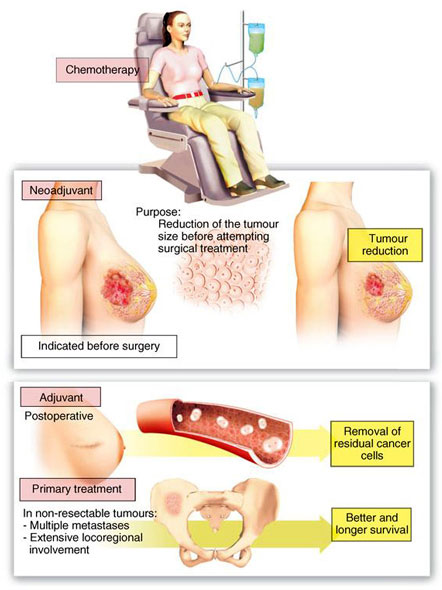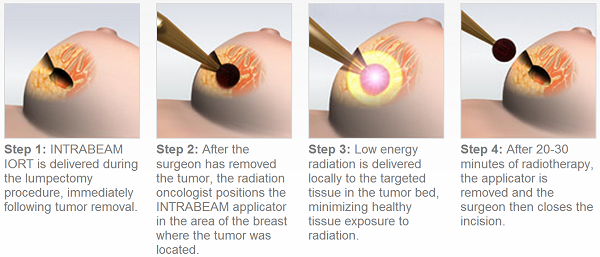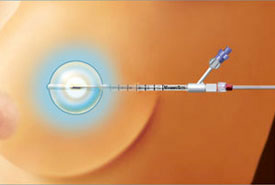Know what is normal for your breasts
Breast Cancer Treatment
With many new life-saving treatment advances against breast cancer, women have more options than ever.
The right treatment depends on multiple things. You and your doctors will arrive at the right treatment plan for you.
SURGERY
Most women with breast cancer have surgery to remove their tumor. Surgery is generally combined with other types of treatment.
Types of surgery used to remove tumors include:

Removes only the tumor and a small amount of the tissue surrounding it. This kind of surgery is usually followed by radiation.
Removes the entire breast that has the tumor. After a mastectomy, reconstructive surgery can rebuild your breast so it is about the same size and shape as it was before.
During your surgery you may have your lymph node checked:
Checks to see if cancer has spread to other parts of the body by removing the first lymph node(s) cancer is likely to travel to.
Based on the doctor’s physical exam and other indicators about the likelihood that cancer has spread to your lymph nodes, the surgeon will generally remove between five and thirty nodes during a traditional axillary dissection. This is typically done if the sentinel lymph node biopsy is positive for cancer.
What is a breast surgeon?
A breast surgeon is a surgeon who has a strong commitment to the care of patients with benign (noncancerous) and malignant (cancer) breast disease. All breast surgeons in the United States have completed a surgical residency. Some breast surgeons have completed additional training, called a fellowship, which was dedicated to breast surgery or oncology. Others who have been a surgeon for many years may have begun practicing long before breast surgery fellowships were available.
Many breast surgeons have practices that are limited to breast patients; that is, they don’t treat any other types of patients.
Reconstructive Options include:
- An implant that is filled with either saline (saltwater) or silicone gel.
- Tissue transplanted from your own back, belly, or buttock (with or without additional implants).
- A reconstructed nipple (tattooed or made from your own transplanted tissue).
For more information about reconstruction click here.
Breast Cancer Treatments
Chemotherapy
Hormonal Therapy
Some breast cancers grow in response to estrogen and progesterone. Hormonal treatments work by lowering the amount of estrogen and progesterone in the body.
Your doctor will pick the right medication for you since there are many types to chose from. These range from aromatase inhibitors, selective estrogen receptor modulators, and estrogen receptor downregulators.
Hormonal therapy medicines are NOT effective against hormone-receptor-negative breast cancers.
Remember Hormonal Therapy is not the same as Hormone Replacement Therapy (HRT). HRT is used to replace estrogen and progesterone to combat the side effects of menopause. This works in opposition to Hormonal Therapy.

Radiation
Radiation May Be Used After A Mastectomy If:
- The cancer is 5 centimeters or large.
- The cancer had invaded the lymph channels and blood vessels in the breast.
- The removed tissue has a positive margin of resection.
- Four or more lymph nodes were involved OR, for premenopausal women, at least 1 lymph node was involved.
- The cancer has invaded the skin (with locally advanced or inflammatory breast cancer).
Radiation is Typically Used After a Lumpectomy or Breast Conserving Therapy.
Types of Radiation
External Radiation
External beam radiation is typically given after a lumpectomy and sometimes a mastectomy. This is the most common type of radiation. This is given over a 6 week period (Monday through Friday) traditionally. Some doctors are able give accelerated breast irradiation in select patients over a shorter time time period.
Hypofractionated radiation therapy: Radiation is given in larger doses using fewer treatments – typically for only 3 weeks. This is done in very select patients who have early stage breast cancers who had breast conserving therapy.
3D-conformal radiotherapy: This is given with special machines so that it is better aimed at the area where the tumor was removed (tumor bed) twice a day for 5 days.
Intraoperative radiation therapy (IORT): At the time of breast conserving therapy, a single large dose of radiation is given in the operating room right before the breast incision is closed.

Brachytherapy
Brachytherapy can be Interstitial or Intracavitary.
Interstitial brachytherapy uses several small, hollow tubes called catheters are inserted into the breast around the area where the cancer was removed and are left in place for several days.
Radiation is given by a physician who specializes in radiation oncology. Radiation oncologists work closely with other medical specialists, especially surgeons, and medical oncologists, as a part of a team caring for patients with cancer. Radiation oncologists also work closely with radiation oncology medical physicists and radiation therapists to plan and deliver radiotherapy.
Intracavitary brachytherapy: A device is put into the space left by breast conserving surgery and is left in place until treatment is complete. There are several different devices available (including MammoSite, SAVI, Axxent, and Contura). This balloon appearing device is inserted in the breast and has a catheter (tube) that sticks outside the body for 5 days. The radiation source is placed down through the tube and into the balloon device for a short time and then removed. Treatments are typically given twice a day for 5 days as an outpatient.

Financial Resources
In the state of Georgia, any uninsured, low-income woman who has been diagnosed with breast or cervical cancer should go to the county health department in their county of residence. Information regarding the program can also be obtained from the Georgia Cancer Control Section by e-mail [email protected] or by telephone 404-657-6611.
- American Society of Breast Surgeons
- Am. Society of Plastics & Recon. Surgery
- American Cancer Society
- American Society of Clinical Oncology
- Centers Disease Control & Prev. (CDC)
- Dr. Susan Love Research Foundation
- East Georgia Cancer Coalition
- Know Your Breast Cancer
- Lynn Sage Cancer Research Center
- National Comp. Cancer Network (NCCN)
- National Cancer Institute (NCI)
- National Society of Genetic Counselors
- SHARE: Self-Help for Women with Breast and Ovarian Cancer
- Susan G. Komen
- Dr. Susan Love Research Foundation
- Triple Negative Breast Cancer Foundation
- Young Survival Coalition

